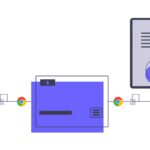With constant advances in technology, outsourcing any and every part of the value chain is getting easier by the day. These new possibilities bring many new advantages such as reduced costs, enabling businesses to focus on their core functions, solving capacity issues, and enhanced product/service quality. On the other hand, they simultaneously raise unique concerns. IT development – the second most commonly outsourced function – is strongly associated with Intellectual Property.
The process of developing software, due to its very nature, may deal with one or several IPs at the same time. The software code itself could be an IP, as could be the ideas and concepts embedded in the code, not to mention any trade secrets that might be divulged to the vendor in the process of creating the software. Then there is the matter of any other client-owned IPs or third party IPs that need to be shared with the vendor. The chief concern of any business is to NOT lose control either of any existing IPs or of any new IPs that are created through outsourcing software development.This guide has been created specifically to help you navigate those tricky matters related to keeping your Intellectual Property safe.
What is Intellectual Property?
There are many types of Intellectual Properties. However, there are five main categories that are frequently associated with software development.
Trade-mark: Trade-mark is used to uniquely distinguish a brand’s goods/services from those of other brands. Its ownership is generally based on common use. However, it can be registered, which is also a recommended business practice because it strengthens your company’s ownership of the trade-mark. A company’s trade-mark is often shared with software developers and could be used as a design element or as a part of the user interface.
Copyright: Copyright protects any original work that expresses an idea. However, it does not protect the idea expressed through the work. The creator of the work is usually considered to be its first owner, unless the work was created within the scope of employment. In the latter scenario, IP rights to the work belong to the employer. The software code itself or certain design elements of the user interface could be subject to copyright.
Trade Secret: Trade Secret is defined as information that others are not aware of and that lends the business an advantage. It remains protected only when secret. There is no registration for trade secrets. Therefore, it has to be safeguarded through other means. When required to be disclosed, it should be clearly defined in the contract as confidential information and protected with appropriate clauses. The software code with embedded ideas could itself be the trade secret. Or else, the developer may need to be made privy to a trade secret in order to create the software.
Industrial Design: The rights to an industrial design are determined through registration. Industrial design registration applies to the finished article and not to specific functional features of the whole design. Again, depending on the nature of the software being developed, developers may either need access to the industrial design or could end up creating software, that ultimately ties in to the protected industrial design.
Patent: Patent rights are applicable to any new invention that fall within the purview of “patentable subject matter” and are protected through a patent registration, which fully describes the invention. Patent rights give the registered owner exclusive rights to buy, sell, or use the described IP. The ideas or concepts within the software code could be patented or patentable.
Who owns it?
As you can see, IP rights can be complicated and may vary greatly with circumstances. However, in most cases, the first owner of the IP is its author, unless the IP is created within the scope of the author’s employment. In the latter case, the employer is the owner. In certain cases, employer cannot own IP rights by default even if the creator is commissioned specifically for the task. In such cases, the rights have to be transferred after the IP is created. As such, a company who is paying to have an IP developed or improved needs to make sure that their ownership of that IP is airtight through legal means.
IP created by employees
In most countries, any IP created by employees within the scope of employment belongs to the employer. However, the employer cannot claim ownership of any IP created outside the scope of employment. For instance, if an individual employed as a software developer creates a work of literary or musical art outside office hours, with their own equipment, etc., the employer cannot claim ownership. Employees can, however, claim moral rights to any work they create even within the scope of employment, viz., while they cannot economically benefit from the IP, they could object to any changes made to it. Hence, it is important to ensure that employee contracts specifically address all rights pertaining to IPs created by employees.
IP created by a contractor/freelancer
IP created by non-employees is not legally protected in the same way unless it is specified in a “work-for-hire” agreement. Therefore, it is vital to have a contract in place wherein the scope of the work, which the developer is hired to do, is defined and wherein the contractor agrees to waive all rights to the IP while assigning them to the company.
Why is it important to protect it?
For many companies, IP is at the core of their business. At the very least, for most businesses, IPs are an essential and valuable asset that they have devoted substantial resources to either develop or acquire. Neglecting to protect such IPs can have serious downsides for their business, both economic and otherwise.
If IP rights are not clarified initially, there could be later legal issues with others claiming full or partial rights over the IP which may severely restrict your ability to change, or even use it.
IPs owned or leased by businesses often play a large role in fulfilling customer warranties. Losing control of them could result in your business failing to deliver on promises to customers which has the two-fold disadvantage of causing financial losses as well as damaging company reputation.
Unregistered or unprotected IPs are open to exploitation by anyone, which may lose your business the edge over competition.
Investor interests are better protected when company assets are secure. These include your company’s IP rights, which put your company in a better position to attract new investment when secure.
How can I protect it?
Before making the decision to outsource, a company should put these best practices in place to ensure that their IPs are adequately protected.
- Conduct an IP due to diligence inquiry. This is basically a review of all existing IPs and IPs in use. It includes but is not limited to determining ownership rights of all IPs; reviewing contracts associated with them (confidentiality, licensing, etc.); identifying any third party IPs being used by the company along with their terms of licensing, expiration, or exit; determining jurisdiction, governing laws, as well as dispute resolution procedures applicable to each IP owned, leased, or in use; and finally, determining any other responsibilities related to IPs such as maintenance, upgrade, insurance, etc.
- Whenever possible, register your IPs and acquire legal documentation with a proper description of the IP. Failing that, you could send yourself or your solicitor a copy of the IP documentation through a registered post and store it somewhere safe and unopened. This does NOT afford the same level of protection as registering an IP. However, in cases of dispute, it could help establish that you were in possession of that IP at the recorded date of the post.
- It is important to understand what legal recourse you will have under the local laws if your IP rights are infringed. Be fully informed about IP laws in the country where the outsourced partner is located, including if your existing patents and copyrights apply to your partner. If uncertain, hire competent local counsel to advise you.
- Research the partner and their reputation thoroughly. Review their security measures as well as the processes they have in place for IP protection.
- Once you decide which IPs you need to disclose for the project, sign an NDA with the developer.
The Non-Disclosure Agreement
Key points of an NDA are:
Parties involved: Parties disclosing confidential information and parties receiving confidential information are specified. NDAs can be unilateral or bilateral, depending on whether only one party intends to reveal information or if both parties do.
Reason for disclosure: Description of the context of disclosure and the reason for it.
Information: Description of the confidential information and/or documents that are the subject of NDA.
Scope: Description of any and all activities that the recipients are prohibited from performing with respect to the revealed information. This section should be specific and cover all possible means of information disclosure – copying, duplication, distribution, etc.
Remedy: Terms of compensation in case of receiving party breaching the confidentiality agreement.
Exclusions: Description of conditions under which either of the parties is released from the scope of obligations mentioned in the contract, for instance, if the information were to go public or if the recipient received the same information from an independent source.
Duration: Defining the time period during which the NDA is enforceable. An NDA usually lasts for a number of years including the term of work and a few years beyond that. This section should specify that upon the expiration of the term only the non-disclosure obligations on the recipient are released, while your IP rights remain intact.
How can I protect my IP while working with independent contractors?
1.Software development contract
Sign an ironclad software development contract with the developer. Be sure to include the following provisions related to Intellectual Property protection in the contract.
- List the law of your jurisdiction as the governing law of the contract. This way, any dispute related to the contract can be resolved under your local laws.
- Include confidentiality/non-disclosure terms covering the new IP that is to be created (any existing IP is assumed to have been covered by the NDA).
- Clarify that you will be the sole owner of any IP created for the full duration of the contract – including but not limited to the source code – with full rights to do what you wish with the IP at any point, such as sell, change, distribute, etc.
- In case the contract is terminated by either party for any reason, you will have access to any IP created thus far including all documentation and all versions of the product, including the failed ones. It is the developer’s responsibility to adequately destroy any remaining documentation, copies, or any other form of material in a manner that is not recoverable in the future.
- The developer should inform you if they are working with any of the business’s competitors.
- Developers should give a warranty that they will not use, sell, or license the IP or any version of the IP created for the client during or after the termination of the contract. (They are, however, free to use the know-how they have acquired while working with you.)
- The developer is required to inform you if any 3rd party IP is used in the process of creating the IP. You, the client, should be indemnified against any infringement of 3rd party IPs.
- Details of compensation due to client if the terms of the contract are breached.
2.Vendor employee agreements
Most outsourcing companies have individual agreements with employees as a good business practice. As the client, insist on reviewing employee agreements to ensure that they adequately cover client confidentiality as well as client IP rights. This will further protect you from unexpected claims over your IP. Any developer who takes IP protection seriously would already have the right and proper employee agreements in place.
3. Securing IP with a system of permissions
Limit access to your IP. Everyone working on the project doesn’t need to have unlimited access to all information. Establish a system of permission levels for the project and insist that the developer follows it. Make certain that the developer has adequate protection in place to ensure that your IP is only accessed by authorized personnel.
In a Nutshell
Intellectual Property could make up for a substantial proportion of a company’s valuable assets. Loss of control over these IPs could significantly impact a company’s ability to achieve its business goals. As such, recognizing IPs of value to your business and securing them in the best way possible should be a core business strategy for every business, big and small. This can be done by following industry best practices for Intellectual Property such as registration, adequate protection, and access limitation. While working with an independent contractor, an NDA should be signed before the negotiation/discussion stage and a software development contract before the start of the project. Both of these should have clear provisions for IP ownership and protection.
As VSH Solutions, we take client IP rights and IP protection very seriously. To know more about how we keep your IP safe while developing software, email us or give us a call.



